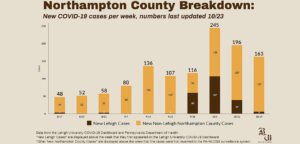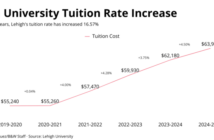Data from both Lehigh’s COVID-19 dashboard and the Pennsylvania Department of Health shows the potential impact the recent outbreak on campus has had on the larger community.
Lehigh’s COVID Response Team announced a scaleback of campus activity on Oct. 2, after 22 new positive cases were reported on and off campus. Since that announcement, at least 151 positive cases have been reported. In a one-week span, active cases dropped from 82 to 28 as of Oct. 23.

Graphic by Jenna Simon/B&W Staff
The chart above compares Lehigh’s new COVID-19 cases to those of Northampton County. During the week of Sep. 28, new Lehigh cases made up over 50 percent of all new cases in Northampton County. The following week, Lehigh students contributed to approximately 40 percent of new positive COVID-19 cases in Northampton County.
These figures beg the question: How badly did Lehigh’s COVID-19 outbreak affect the greater Northampton County community?
While there is no clear evidence that Lehigh students directly affected other citizens of Northampton County, the data does suggest that Lehigh’s COVID-19 outbreak played a role in increasing positive cases in the area.
The week of Sep. 14, in which Northampton County had 136 positive cases, appears to be an outlier. This number dropped until cases at Lehigh went up. During the peak of the outbreak at Lehigh, the university was reporting a positivity rate of four percent in its weekly surveillance testing. That number has since dropped to close to one percent.
A major concern worldwide has been the transmission of the virus between young people, a demographic much less likely to be affected as severely.
Maggi Mumma, deputy press secretary at the Pennsylvania Department of Health, said in April, six percent of cases in Northeastern Pennsylvania were between the ages of 19 and 24. Today, that number has increased to approximately 20 percent of all cases in the region.
Gov. Tom Wolf said earlier in October he was concerned about rising case numbers in the state, specifically citing the opening of Pennsylvania colleges and universities as one factor driving up the case count. The Keystone State recorded a pandemic-high 2, 219 cases on Friday, and Saturday also saw more than 2,000 cases in Pennsylvania.
“The Department of Health remains significantly concerned about the potential spread of this virus, particularly among young people,” Mumma said. “Health care officials all across the state are seeing a rise in COVID-19 cases in young people.”
Mumma said cases are recorded in the county in which the person is spending the majority of his or her time. Since the student is spending “more of the year” near campus than at home, the case would count in the college’s county. Lehigh is also reporting cases among students specifically in the Bethlehem area on its dashboard, so the Department of Health’s Northampton County data and the university data are likely to align with one another.
In response to the outbreak, Lehigh administration moved the campus to all remote learning, closed all gyms and libraries, shut down athletics, increased testing and moved dining to takeout only. Additionally, over 200 students living on campus have gone home after the new restrictions were announced.
Since the number of cases has fallen significantly, Lehigh announced it would reopen parts of campus on Oct. 26.
“From the outset, Lehigh’s strategy has included the idea that any new information, such as an increase in positive cases or changes in guidance from health authorities, would be met with new protocols, such as greater restrictions and increased testing, as was implemented a few weeks ago the moment an outbreak was suspected,” said Lori Friedman, director of media relations.
She also said the administration’s strategy included a plan for the occurrence of an outbreak, in addition to outbreak prevention. The Brown and White originally requested to speak with David Rubenstein, executive director of the health center, on this issue, but was directed to Friedman instead.
Lehigh said in a recent email the spread of COVID-19 likely stemmed from informal student gatherings at off campus locations and the interactions between those living on and off campus.
“We didn’t recognize our responsibility to be the best community members we could’ve been,” said Eve Freed, president of Student Senate.
Although it’s understandable to have social bubbles in a pandemic, she said, these social bubbles are bound to overlap on a college campus. Freed said she has concern about how Lehigh is impacting the greater community in terms of COVID-19
“I think that there should’ve been a greater emphasis sooner on how this was going to impact the community’s mental health,” Freed said. “The outbreak occurred the same time as when we would’ve been approaching pacing break.”
With just a month to go before all in-person activity stops at Thanksgiving break, the administration will soon have to turn to a decision on the spring semester. Lafayette College, for example, already announced it would have students living on campus in the spring.
Jordan Wolman contributed to this article.





Comment policy
Comments posted to The Brown and White website are reviewed by a moderator before being approved. Incendiary speech or harassing language, including comments targeted at individuals, may be deemed unacceptable and not published. Spam and other soliciting will also be declined.
The Brown and White also reserves the right to not publish entirely anonymous comments.
1 Comment
I see you didn’t say anything about Deaths. People are recording Cases but not saying much about Deaths.